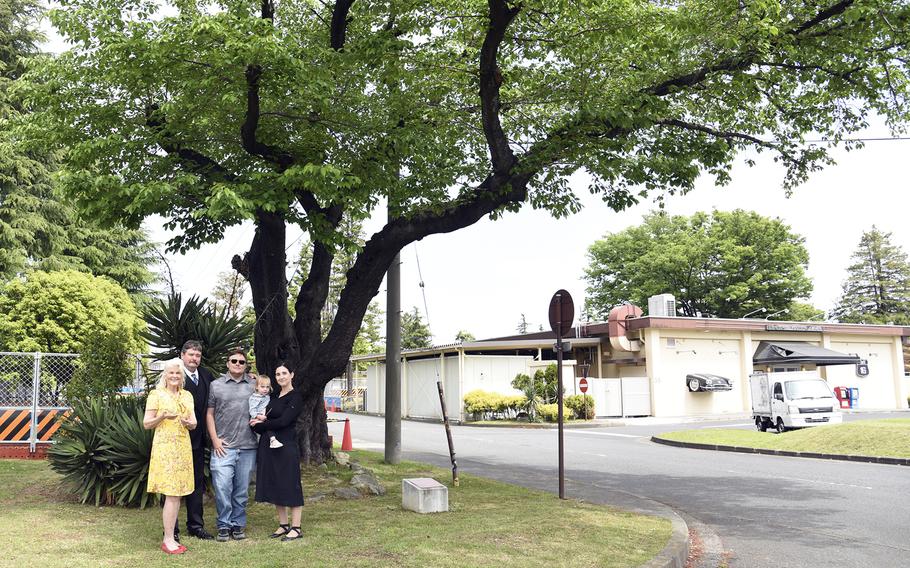
The family of former Yokota commander Col. Fred Stevers pose with the Japanese American Community Relations Tree on the air base in western Tokyo, April 23, 2023. The cherry tree, a gift to Stevers from local leaders, was planted on April 23, 1953. (Kelly Agee/Stars and Stripes)
YOKOTA AIR BASE, Japan — Four generations recently stood under a 70-year-old cherry tree at this U.S. airlift hub in western Tokyo that is known for its broad avenues lined with sakura.
The tree has a distinctive history attached to it. It was a gift in the 1950s from leaders of the surrounding Japanese communities to the base and its commander at the time, Col. Fred Stevers, as a sign of friendship.
“Just knowing my father had so much to do with Japan and how he loved the Japanese people and then to plant a tree for friendship, it’s overwhelming to me,” daughter Becky Armstrong, 81, told Stars and Stripes on April 23. “At my age, it’s like he is so glad that I’ve come back and honored his memory.”
Armstrong and a family entourage representing four generations traveled from Nevada to see what is called the Japanese American Community Relations Tree. The group included her son Ray Armstrong; grandson Eli Armstrong and his wife, Jackie; and granddaughter Adeline Armstrong.
The cherry tree on Spaatz Drive near the Route 16 Diner is the oldest tree planted by the U.S. military on the base, according to 374th Airlift Wing historian Lesleigh Jones.
It was planted on April 23, 1953. In exchange for the gift, Stevers gave the Japanese leaders a palm tree, according to photos and documents provided by Ray Armstrong.
A plaque near the cherry tree labels it Historical Site Number 19 and provides a brief summary of its history, stating it represents the ongoing friendship between the people of Yokota and the surrounding community. But it makes no mention of Stevers.
The family’s visit to Yokota started when Ray Armstrong posted a message on the base’s official Facebook page asking for an escort to the tree. Air Force spouse Crystal Branco offered to help.
Ray Armstrong had made five visits to the tree, the last in 2019. But this was the first for his mother, who did not live in Japan while her father was serving overseas.
“My mom has never been to Japan and, since this is the 70th anniversary today of the tree, she really needed to be here,” he said.
Branco let base headquarters know about the significance of the Armstrongs’ visit.
“I feel like I am helping to piece together history,” she said. “I was able to facilitate history. And I know it's just a tree, but it's like the last visual remnant of what impact he made on the base.”
Stevers, of San Diego, took command at Yokota on Aug. 21, 1952. He received the key to Tokyo in 1955 from Seiichiro Yasui, governor of Tokyo from 1947 to 1959.
During the Armstrongs’ visit, the family met Col. Julie Gaulin, vice commander of the 374th Airlift Wing.
“I'd really just like to thank the family for coming out here and sharing this special moment and showing us the key to the city,” Gaulin said on April 23. “You know, that is a testament to the impact that he made here. It's what we can all aspire to, to make those lifelong impacts for people because the relationship between the United States and Japan is so important.”
The U.S. Japan Goodwill Community Council, established in 1952 under Stevers’ guidance, promoted the relationship between the U.S. and Japan through social welfare activities. He also helped establish an orphanage, the Half-Blooded Children’s Home, in Fussa city in 1953, according to a letter of appreciation from Yasui.
Though Stevers is gone, his memory lives in his children, grandchildren and great grandchildren and a cherry tree that is still flourishing.
Becky Armstrong said her father’s military service was a big thing for him.
“He had a total dedication to the military,” she said.